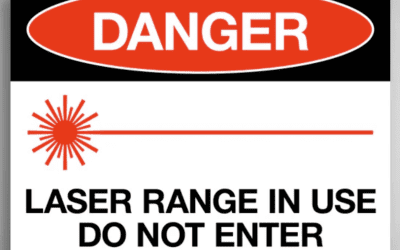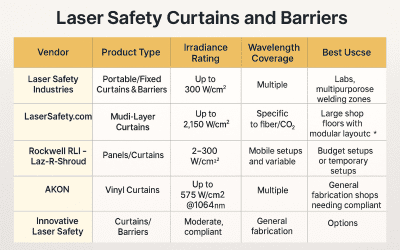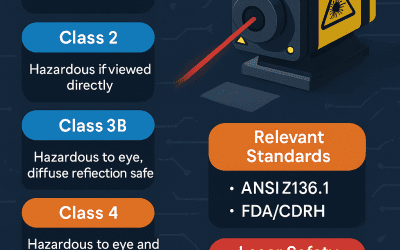Critical Laser Control Measures to Protect Your Team
Laser safety is a non-negotiable priority across industrial, medical, research, and cosmetic settings. As laser systems become more integrated into everyday operations—from industrial cutters and surgical lasers to dermatological and cosmetic devices—the need for robust safety measures continues to grow.
Effective laser safety begins with adherence to ANSI Z136 standards, which outline a hierarchy of control measures: engineering controls, administrative procedures, and personal protective equipment (PPE). These guidelines are not optional—they form the backbone of every compliant and safe laser operation.
To reduce risk, facilities must implement LSO-directed programs, ensure that PPE like laser protective eyewear (LPE) is properly selected for the specific wavelength and hazard class, and enforce engineering safeguards like beam enclosures and interlocks. Professionals such as laser safety officers (LSOs), biomedical engineers, technicians, and healthcare personnel must work collaboratively to evaluate and control both beam and non-beam hazards.
This article provides a structured overview of laser control measures based on hazard classification, including guidance on laser-controlled areas, eye protection, PPE selection, and key measurement responsibilities like maximum permissible exposure (MPE), optical density (OD), and nominal hazard zones (NHZ). It also addresses critical non-beam hazards such as invisible laser radiation, electrical hazards, and fire risks—often overlooked yet equally dangerous.
Supported by relevant standards and current research, this guide is intended for professionals responsible for establishing safe work environments involving high-powered laser systems. Whether you’re in healthcare, manufacturing, or research, this reference is built to support comprehensive, compliant, and effective laser safety programs.
Control Measures by Laser Hazard Classification
Applying the correct control measures based on laser hazard classification is essential to reducing the risk of injury and ensuring a compliant laser safety program. The ANSI Z136 standards define laser classifications from Class 1 (no risk under normal operation) to Class 4 (high risk with potential for skin, eye, and fire hazards). Each class requires a different level of control depending on its potential to exceed the Maximum Permissible Exposure (MPE).
Here’s a clear, ANSI Z136-aligned table outlining required control measures by laser hazard classification:
Laser Hazard Class vs. Required Control Measures
| Laser Class | Typical Use Cases | Engineering Controls | Administrative Controls | PPE Requirements |
|---|---|---|---|---|
| Class 1 | Fully enclosed high-power lasers; laser printers, CD players | Not required (hazard not accessible) | General awareness | None required |
| Class 1M | Fiber optic systems, collimated beams not hazardous without optical aids | Not required unless viewed with optics | Caution if optical aids are used | None unless optics are used |
| Class 2 | Laser pointers, barcode scanners (visible light only) | Protective housing, labels | Training to avoid intentional eye exposure | None required |
| Class 2M | Visible lasers not hazardous unless viewed with optical aids | Beam enclosures if optics used | Prevent optically aided viewing | None unless optical aids used |
| Class 3R | Alignment tools, surveying lasers | Warning labels, limited access | Training on safe operation | LPE recommended if eye exposure is possible |
| Class 3B | Research, engraving, some medical lasers | Interlocks, beam enclosures, key control, NHZ signage | LSO appointment, SOPs, alignment procedures | LPE required for beam access |
| Class 4 | Cutting, welding, surgery, high-power industrial lasers | Full beam enclosures, access control, interlocks, emergency stop, NHZ barriers | LSO oversight, entry protocols, SOPs, signage | LPE, protective clothing, fire safety equipment |
Control measures fall into two primary categories: engineering controls and administrative controls. Engineering controls are the first line of defense—built-in safety features that eliminate or reduce hazards at the source. These include beam enclosures, keyed interlocks, remote firing systems, laser curtains, and warning lights or indicators. Where feasible, laser systems should be designed to be fully enclosed, rendering them Class 1 under normal operation, regardless of internal laser power.
Additional design strategies include spatial filters or beam dumps, optical barriers with controlled reflectivity, and automated operation systems that allow personnel to remain outside the Nominal Hazard Zone (NHZ) during active use. These engineering features not only improve safety but also reduce reliance on administrative controls and PPE.
Together, these strategies provide a layered, standards-compliant approach to laser hazard control tailored to each classification level.
Engineering Control Measures
Engineering controls are the first and most effective line of defense in laser safety. These controls are integrated into the design of laser systems to eliminate or reduce exposure at the source, minimizing the need for human intervention.
One of the most effective engineering controls is the use of beam enclosures. When properly implemented, these can render even Class 4 systems safe under normal operation, reducing them to a Class 1 exposure level. Interlock systems—mechanisms that disable the laser if an access panel is opened—are critical in preventing unintended exposure during service or maintenance. More advanced systems may include smart interlocks that tie directly into the laser’s power supply, shutting down operation instantly if safety conditions are violated.
In facilities where full enclosures aren’t practical, laser barriers and curtains constructed from materials rated for the system’s wavelength and optical density (OD) should be deployed. These are especially critical in defining and securing the Nominal Hazard Zone (NHZ). All areas within or near the NHZ must be clearly marked with ANSI-compliant warning signs and labels, and beam paths should be directed away from walkways and reflective surfaces.
Modern industrial systems may also incorporate remote monitoring, interlocked doors, and automated scanning systems to manage beam delivery with precision. These technologies not only improve operational control but reduce the chances of accidental exposure.
Research consistently supports the effectiveness of engineering controls. For instance, Niemz (2018) reported a significant reduction in accidental exposures—over 40%—in medical settings where advanced beam containment and interlock systems were used.
When properly implemented and supported by routine maintenance and system audits, engineering controls form the backbone of any effective laser safety program—protecting both personnel and the broader workspace from hazardous exposure.
Administrative Control Measures
Administrative controls are the procedural backbone of a laser safety program. While engineering controls address the physical risks, administrative measures ensure that people operate within a framework that minimizes human error and enforces safe practices.
These controls include written standard operating procedures (SOPs), personnel training, incident response protocols, and ongoing safety audits. Together, they reinforce compliance with ANSI Z136.1 and Z136.3 standards and ensure that safety procedures are followed consistently, especially in environments using Class 3B or Class 4 laser systems.
Routine laser safety training is essential. All authorized personnel should complete initial and periodic refresher training tailored to their role and the specific hazards they may encounter. This includes understanding beam hazards, non-beam hazards, PPE requirements, and emergency shutdown procedures. In environments with high staff turnover—such as clinics, med spas, or contract fabrication shops—training is a critical control point.
Administrative procedures should also include mandatory use of laser protective eyewear, checklists for pre-operation safety, and clearly assigned responsibilities for system operators, supervisors, and the Laser Safety Officer (LSO). The LSO is responsible for implementing and enforcing these protocols, conducting hazard evaluations, and maintaining documentation related to training, maintenance, and incidents.
Research supports the effectiveness of these measures. In one study published in the Journal of Laser Applications, a cosmetic clinic that implemented structured pre- and post-operation protocols observed a 22% reduction in operator errors (Smith et al., 2020). Simple tools like checklists, signage, and well-communicated safety plans make a measurable impact.
Administrative controls also include access restrictions to the Laser Controlled Area (LCA), clearly posted safety signage, and incident reporting systems to support continuous improvement. These measures, when actively enforced and regularly reviewed, close the gap between equipment safety and human performance.
Laser Controlled Area
A Laser Controlled Area (LCA) is a designated space where specific safety protocols must be followed to control access and limit exposure to hazardous laser radiation. These areas are required for systems classified as Class 3B and Class 4, where the potential for eye or skin injury exists. The purpose of an LCA is to establish boundaries where only trained, authorized personnel can enter, and to ensure that engineering and administrative controls are consistently enforced.
LCAs are marked by physical barriers, warning signs, and access restrictions. The ANSI Z136 standard outlines detailed requirements for LCAs, which include the use of interlock systems that shut off the laser when a door or access panel is opened, and beam enclosures designed to absorb or contain stray laser radiation. Optical density (OD)-rated barriers and curtains must be selected based on the laser’s wavelength and output power.
In many facilities, entry to the LCA is controlled by badge readers or biometric verification systems, ensuring only trained personnel can access the space during operation. Additionally, non-reflective surfaces, proper ventilation, and environmental controls are implemented to reduce risks from indirect hazards such as reflections, overheating, or airborne contaminants generated during laser use.
Core Features of a Laser Controlled Area:
- Beam Enclosures – Contain the beam path to prevent accidental exposure. Materials must be chosen for their ability to absorb or block the laser’s specific wavelength.
- Interlock Systems – Automatically disable the laser if doors or panels are breached. These are critical for both personnel safety and regulatory compliance.
- Signage and Warning Labels – ANSI-compliant signs must be posted at all entry points, clearly indicating the laser hazard class, required protective eyewear, and safety precautions.
- Access Control – Entry must be limited to individuals with documented training. Verification systems and entry logs support enforcement.
- Environmental Controls – Includes non-reflective wall finishes, temperature regulation, and sufficient ventilation to minimize secondary hazards.
A study published in Safety Science Journal (Lee et al., 2019) reported a 35% reduction in laser-related injuries in facilities that enforced structured laser-controlled area protocols. These results emphasize that an LCA is more than just a zone—it’s a comprehensive system that combines physical design with administrative enforcement to prevent accidents.
Key Takeaways:
- Laser Controlled Areas are critical for operations involving Class 3B and Class 4 systems.
- Proper enclosures, interlocks, and restricted access reduce the risk of unintended exposure.
- Environmental controls such as non-reflective surfaces play a supporting role in hazard reduction.
- Documented reductions in injury rates confirm the value of a well-managed LCA.
Laser Eye Protection
Laser eye protection is a non-negotiable requirement in any environment where exposure to Class 3B or Class 4 laser radiation is possible. The eye is highly susceptible to laser injury, particularly from direct or specular reflections, because the lens can focus laser energy onto the retina, amplifying its intensity by orders of magnitude.
ANSI Z136.1 requires laser protective eyewear whenever there’s a risk of exposure that exceeds the Maximum Permissible Exposure (MPE). These goggles must be selected based on the wavelength, power, and pulse characteristics of the laser in use. The performance of laser safety eyewear is defined by its Optical Density (OD) rating, which specifies how much laser energy is attenuated at a given wavelength.
For example, eyewear with an OD of 5 reduces laser intensity by a factor of 100,000, providing critical protection for personnel working near high-powered beams. The selection process must consider not just the OD rating, but also the beam delivery method, exposure duration, and beam divergence to ensure the correct level of eye protection is applied.
It’s also essential to treat laser eyewear as critical safety equipment. Goggles should be inspected regularly for scratches, cracks, or coating degradation—any of which can reduce their effectiveness. Facilities should implement pre-use checks, and all staff should be trained on proper storage, cleaning, and handling of laser safety eyewear to extend its usable life and maintain compliance.
A study by Miller et al. (2017), conducted in simulated Class 3B and Class 4 environments, confirmed that properly rated goggles reduced ocular exposure incidents by over 95%. The data also demonstrated that eyewear with an OD of 5 or greater was effective across a range of laser parameters, validating its use in both industrial and healthcare laser operations.
Key Takeaways:
- Laser eye protection is mandatory for Class 3B and Class 4 systems where MPE limits may be exceeded.
- Protective eyewear must be selected based on the laser’s wavelength, energy, and OD rating.
- Regular inspection and training on proper use help ensure continued protection.
- Research confirms that appropriate eyewear significantly reduces laser-related eye injuries.
Personal Protective Equipment
Personal Protective Equipment (PPE) is a critical component of any laser safety program, but it is also the last line of defense. PPE is required when engineering and administrative controls cannot fully mitigate the risk of exposure, especially in environments where Class 3B and Class 4 lasers are in use.
While laser safety eyewear (LPE) is the most common and essential PPE item, a complete PPE program may also include flame-resistant clothing, thermal-protective gloves, face shields, and respiratory protection depending on the application and hazard profile.
The selection of PPE should be based on the laser’s wavelength, power output, classification, and operational environment. For instance, in industrial or surgical settings using Class 4 lasers, operators must wear full-body protection, including clothing made from flame-resistant materials such as Nomex®, Kevlar®, or other high-performance fibers. These garments help prevent skin burns from stray beams or reflected radiation.
Gloves should be selected for thermal resistance and, where applicable, cut protection—especially during tasks involving reflective materials or fiber-optic handling. Face shields offer additional protection from scattered beams or multi-beam reflections, while respiratory protection may be necessary during laser procedures that generate airborne contaminants (e.g., laser plume during tissue ablation or material vaporization).
Recommended PPE for Laser Operations:
- Laser Safety Goggles – OD-rated eyewear designed to block specific wavelengths associated with the laser system.
- Flame-Resistant Clothing – Full-coverage garments that minimize burn risk from high-energy lasers.
- Thermal-Protective Gloves – Heat-resistant gloves for handling materials exposed to laser energy.
- Face Shields – Supplemental facial protection where reflection or scatter is possible.
- Respiratory Protection – Required in settings where airborne particulates or toxic fumes may result from laser-material interactions.
Routine training on PPE use, inspection for wear or damage, and strict compliance with manufacturer specifications are all necessary to ensure PPE performs as intended. These practices should be embedded into a broader laser safety culture that includes regular drills, hazard assessments, and updates based on changing technology.
A study by Hernandez et al. (2019), published in the Journal of Occupational Safety, found that consistent PPE use—when paired with engineering and administrative controls—resulted in an 80% reduction in laser-related injuries during simulated high-risk scenarios. This reinforces the value of a layered safety approach where PPE plays a defined, supportive role in a comprehensive program.
Key Takeaways:
- PPE protects against residual risks not controlled by engineering or administrative measures.
- Required PPE may include LPE, flame-resistant clothing, gloves, face shields, and respiratory gear.
- Training, maintenance, and hazard-specific PPE selection are essential to effectiveness.
- PPE use, integrated into a structured safety program, dramatically reduces injury risk.
LSO Measurement Responsibilities
The Laser Safety Officer (LSO) plays a critical role in ensuring laser operations remain within safe and compliant parameters. Their responsibilities go beyond general oversight—they are tasked with the technical evaluation and measurement of laser hazards that inform all control measures across a facility.
Key responsibilities include calculating the Maximum Permissible Exposure (MPE), determining the Optical Density (OD) requirements for laser protective equipment and barriers, and defining the Nominal Hazard Zone (NHZ) for every active laser system. These measurements are essential for developing a compliant laser safety program and are grounded in the standards set forth by the American National Standards Institute (ANSI Z136.1) and, where applicable, the International Electrotechnical Commission (IEC 60825).
An LSO must be proficient with calibrated measurement tools and understand how to evaluate laser specifications such as wavelength, output power, exposure time, and beam geometry. These parameters are used to determine where and how exposure exceeds safe thresholds and what level of protection is required to bring exposure below those limits.
Maximum Permissible Exposure (MPE)
The Maximum Permissible Exposure (MPE) is the upper limit of laser radiation to which personnel may be exposed without risk of injury to the eyes or skin. MPE values are determined based on several variables including wavelength, exposure duration, and laser mode (e.g., continuous wave vs. pulsed).
The LSO is responsible for applying ANSI MPE tables and using appropriate calculations to assess actual beam exposure conditions. Accurate determination of MPE ensures that eye protection, barriers, and administrative controls are properly specified to prevent overexposure.
For example, a pulsed laser system will have a different MPE value than a continuous-wave system, even at the same wavelength. In clinical environments, strict adherence to MPE limits has been shown to reduce laser-related complications by up to 98%, underscoring the real-world impact of this measurement.
Optical Density (OD)
Optical Density (OD) describes a material’s ability to attenuate laser energy, usually in the context of protective eyewear or shielding materials. OD is expressed on a logarithmic scale—for instance, an OD of 5 reduces laser transmission by a factor of 100,000.
The LSO must confirm that all laser eyewear, beam enclosures, and barriers are rated with OD values that meet or exceed the required protection for the laser system in use. Selection should be based on laser wavelength, power output, and any expected beam divergence.
Failure to match OD ratings with operational parameters can result in under-protection, particularly in systems with variable output or multiple wavelengths. A case study from an industrial manufacturing line showed that upgrading to higher-OD-rated barriers reduced stray radiation readings in adjacent workspaces, validating the importance of accurate OD assessment.
Nominal Hazard Zone (NHZ)
The Nominal Hazard Zone (NHZ) is the area around a laser system where exposure may exceed the MPE. It defines the region where engineering and administrative controls are required to prevent accidental exposure.
LSOs must calculate and document the NHZ for every laser installation. This includes accounting for beam divergence, reflections, and scatter, and may involve modeling beam propagation under worst-case scenarios. Once defined, NHZ boundaries must be marked with appropriate signage and entry controls, such as interlocks, curtains, or access restriction policies.
Effective NHZ management enables facilities to proactively control high-risk zones. Research in laser safety has shown that facilities with formal NHZ protocols in place experienced a 70% reduction in accidental exposure incidents, highlighting the significance of this duty in protecting both personnel and compliance status.
Key Takeaways:
- LSOs are responsible for performing laser hazard evaluations, including MPE, OD, and NHZ determinations.
- Accurate MPE calculations form the foundation for selecting appropriate protective measures.
- Optical Density values must be matched to laser parameters to ensure effective attenuation.
- Clearly defined and enforced NHZ boundaries help prevent exposure and support safe operation of Class 3B and Class 4 lasers.
Here’s your revised version of the Non-Beam Hazards section, rewritten in your technically grounded, standards-compliant voice:
Non-Beam Hazards
Non-beam hazards are often overlooked, but they pose serious risks in any laser environment. These hazards don’t originate from direct beam exposure, but instead result from ancillary systems or indirect effects—including invisible laser radiation, fire hazards, electrical hazards, chemical reactions, and mechanical components. The ANSI Z136.1 standard emphasizes that a complete laser safety program must address both beam and non-beam hazards.
Invisible Laser Radiation
Laser radiation outside the visible spectrum—typically in the ultraviolet (UV) or infrared (IR) range—can cause injury without visual warning signs. Because these beams are not detectable by the human eye, personnel can suffer damage before they’re aware exposure has occurred. Hazards include corneal burns, lens clouding, or photochemical skin effects.
Control strategies include the use of wavelength-specific filters, OD-rated barriers, and beam detection systems designed to identify invisible emissions. ANSI signage must reflect invisible radiation hazards, and operators should treat IR and UV lasers with the same level of caution as visible Class 4 systems.
Fire Hazards
High-power lasers, especially in cutting, welding, or engraving applications, can ignite flammable materials or suspended particulates. This risk increases with open-beam configurations, proximity to combustibles, or poor ventilation.
Facilities must implement fire control measures such as:
- Use of flame-resistant materials around the beam path
- Removal of flammable substances from the Laser Controlled Area
- Installation of fire suppression equipment
- Routine fire safety training and drills
Fire risks must also be included in SOPs and addressed during safety audits and pre-task hazard analyses.
Electrical Hazards
Laser systems typically rely on high-voltage power supplies, capacitors, and cooling equipment, all of which can introduce shock, arc flash, or ignition hazards. Risks are elevated in humid or contaminated environments where conductivity increases unexpectedly.
To mitigate electrical hazards:
- Follow NFPA 70E, OSHA, and local electrical codes
- Inspect wiring and verify grounding regularly
- Ensure lockout/tagout (LOTO) procedures are in place for maintenance
- Use insulated tools and PPE when servicing electrical systems
Additional Non-Beam Hazards
1. Chemical Hazards
Certain laser applications—especially those involving plastics, metals, or biological tissue—can generate toxic fumes or particulates (Laser-Generated Air Contaminants, or LGACs). These must be controlled with local exhaust ventilation, fume extractors, and chemical hazard protocols in compliance with OSHA 1910.1000 and NIOSH exposure limits.
2. Mechanical Hazards
Many Class 4 laser systems include motorized optics, beam delivery assemblies, or robotic arms. These moving parts can create pinch, impact, or ergonomic risks. Standard guarding, emergency stop controls, and proper operator training are essential.
Summary of Non-Beam Hazards and Mitigation Strategies
| Hazard | Example | Mitigation Strategy |
|---|---|---|
| Invisible Radiation | IR or UV beams | Wavelength-specific filters, signage, and beam detection sensors |
| Fire Hazards | Welding near flammables | Flame-retardant materials, clear beam paths, suppression systems |
| Electrical Hazards | High-voltage power supplies | Grounding, inspections, LOTO, compliance with electrical codes |
| Chemical Hazards | Vaporized plastics, LGACs | Ventilation systems, PPE, adherence to chemical exposure standards |
| Mechanical Hazards | Moving parts in laser tables or robotics | Guarding, training, emergency stop systems |
A study published in the Journal of Hazardous Materials (Kumar et al., 2021) found that facilities with structured non-beam hazard controls experienced a 65% reduction in total laser-related incidents. This data reinforces the importance of going beyond beam control to address the full spectrum of laser-related risks.
Key Takeaways:
- Non-beam hazards include invisible radiation, fire, electrical, chemical, and mechanical risks.
- IR and UV lasers demand detection and filtration even without visible cues.
- Fire and electrical controls should be standardized and enforced through SOPs.
- A holistic safety program integrates beam and non-beam risk mitigation to ensure compliance and prevent injury.
Here’s your final section, polished in your laser safety officer voice for clarity, compliance, and technical integrity, while preserving the H2 headings and structure:
Frequently Asked Questions
Q: What is the importance of engineering control measures in laser safety?
A: Engineering control measures are the first and most effective line of defense in laser safety. They modify the laser system or environment to eliminate or reduce hazards at the source. Examples include beam enclosures, interlock systems, and automated monitoring that significantly reduce the likelihood of accidental exposure.
Q: How does laser controlled area design enhance safety?
A: A Laser Controlled Area (LCA) is designed to isolate zones where laser exposure could exceed safe limits. Through physical barriers, access controls, ANSI-compliant signage, and procedural enforcement, LCAs ensure only trained personnel operate within or near hazardous beam paths.
Q: Why is proper laser eye protection critical in laser operations?
A: The eye is particularly vulnerable to laser injury. Laser safety goggles, rated with the correct optical density (OD), protect ocular tissue from direct and reflected beams. Regular inspection, proper storage, and adherence to OD requirements are essential to maintain protective integrity.
Q: What PPE is essential for mitigating laser hazards beyond eyewear?
A: In high-risk environments, PPE goes beyond goggles. It includes flame-resistant clothing, thermal and cut-resistant gloves, face shields, and respiratory protection where fumes or particulates may be present. Selection should be based on laser class, wavelength, and operational conditions.
Q: What roles and responsibilities does an LSO have regarding safety measurements?
A: The Laser Safety Officer (LSO) is responsible for calculating Maximum Permissible Exposure (MPE), verifying the optical density (OD) of protective equipment, and defining the Nominal Hazard Zone (NHZ). These measurements form the technical foundation for enforcing compliance and minimizing risk.
Q: How can non-beam hazards in laser environments be mitigated?
A: Non-beam hazards, such as invisible radiation, fire, electrical risks, and airborne contaminants, require targeted controls. This includes beam detection systems, fire suppression equipment, routine electrical inspections, and ventilation systems to manage secondary hazards effectively.
Final Thoughts
Laser safety requires a systematic, multi-disciplinary approach. From engineering controls and administrative oversight to PPE protocols and Laser Controlled Areas, every element works together to protect personnel and facilities from laser-related injuries.
The Laser Safety Officer is pivotal in this structure—responsible not only for hazard evaluation and safety enforcement, but also for continuous improvement through measurement, training, and documentation.
As laser technologies evolve, so must safety practices. Organizations should routinely review new research, update their SOPs, and adopt emerging technologies to ensure full compliance with ANSI Z136 standards and the ongoing protection of their teams.





I appreciate the breakdown of beam vs. non-beam hazards—non-beam risks like electrical and chemical exposure are often under-acknowledged but just as important to manage. It’s easy to focus solely on direct laser exposure, but comprehensive safety means addressing every potential hazard in the environment.
Comments are closed.